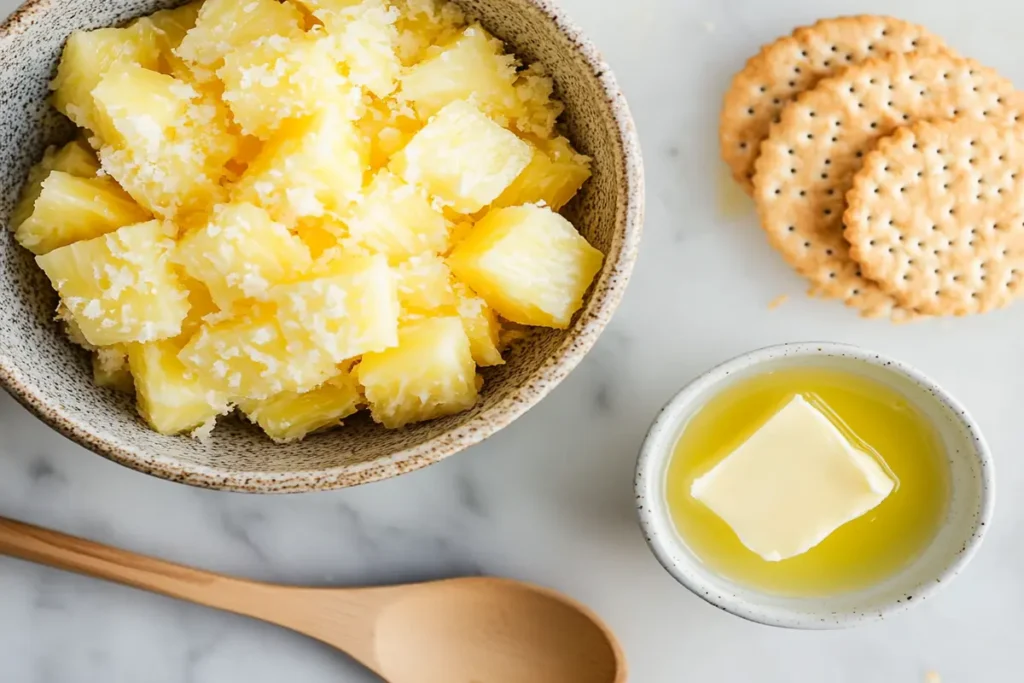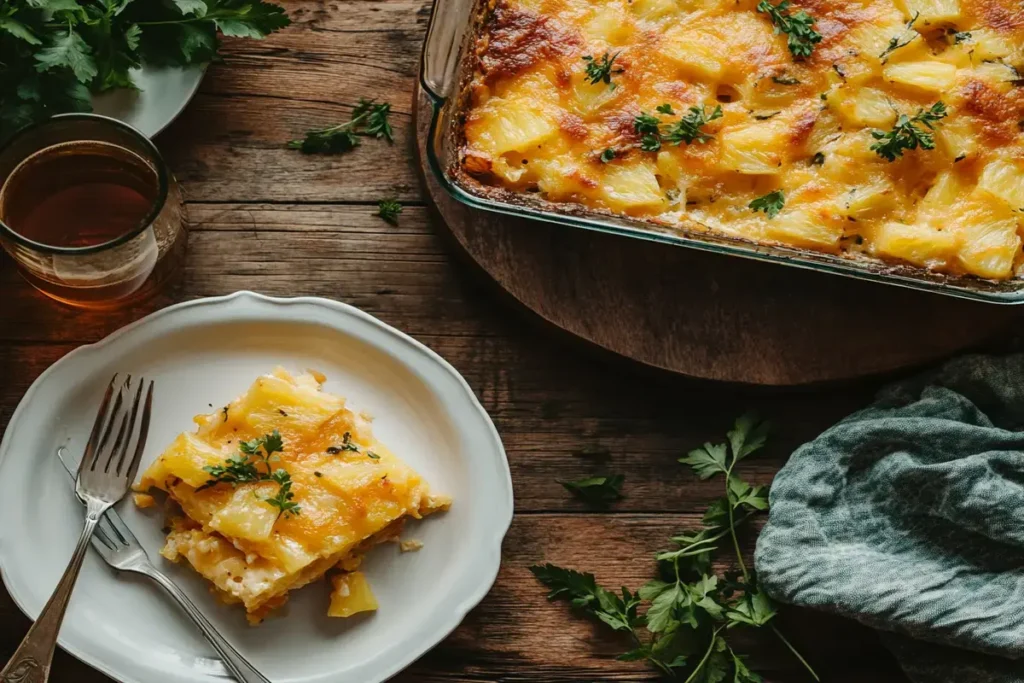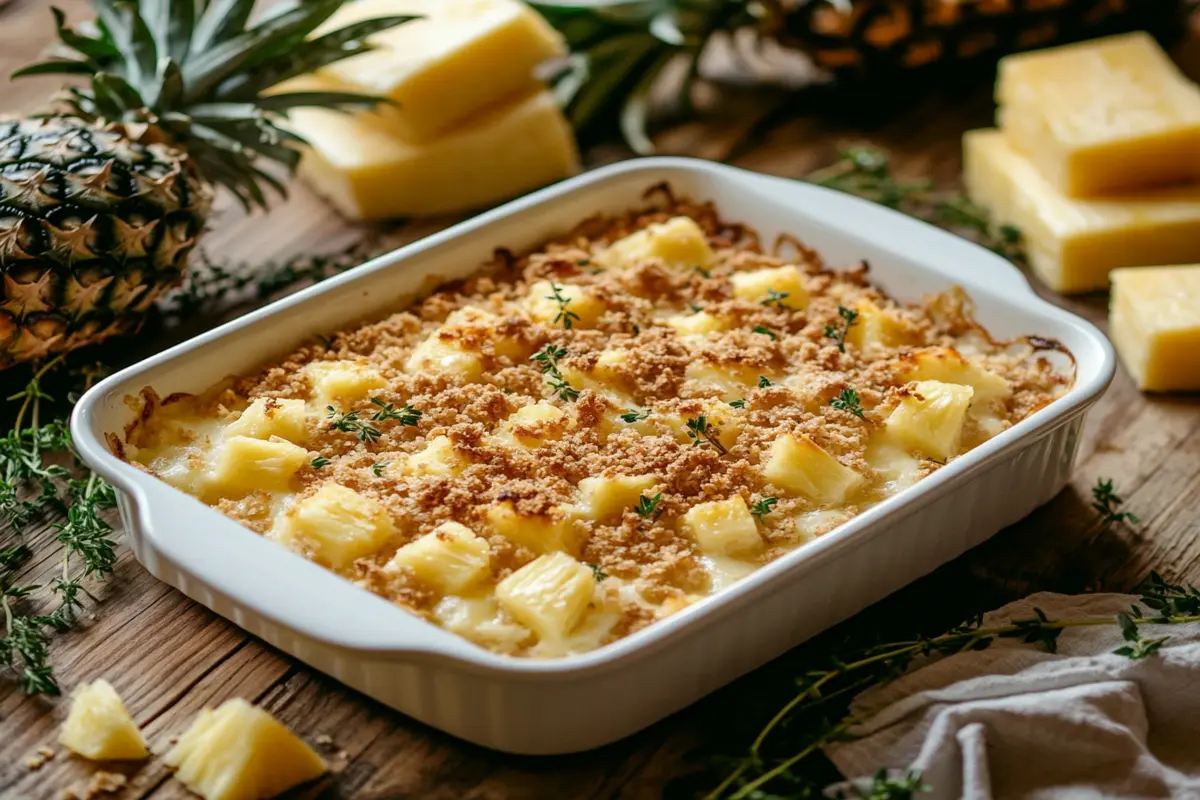If you’re on the hunt for a dish that blends sweet, savory, and cheesy goodness, you’ve landed in the right place! This article dives deep into the pineapple casserole recipe, a classic Southern comfort dish beloved for its unique flavors. From its history and key ingredients to step-by-step preparation and creative serving ideas, this guide has you covered. Whether you’re a first-timer or looking to elevate your existing recipe, there’s something here for everyone. So, roll up your sleeves and let’s explore the delicious world of pineapple casserole!
What Is Pineapple Casserole?
What Makes Pineapple Casserole Unique?
The pineapple casserole recipe stands out because it marries the tangy sweetness of pineapple with the savory richness of cheese. It’s a dish that surprises the palate but leaves you craving more with each bite. Traditionally topped with a crispy layer of buttery crackers, it delivers the perfect balance of textures—soft, gooey, and crunchy.
Origins and History of Pineapple Casserole
This delightful dish hails from the American South, where comfort food reigns supreme. Pineapple casserole became a popular potluck favorite in the mid-20th century, particularly during the holidays. The combination of simple pantry staples like canned pineapple, shredded cheddar, and crackers made it accessible and budget-friendly. Over time, families personalized the recipe, leading to countless variations.
Why It’s a Southern Comfort Classic
In the South, food isn’t just about nourishment—it’s about connection, memories, and celebration. Pineapple casserole, often served alongside ham or turkey, has become a staple at Easter, Thanksgiving, and Christmas dinners. Its ability to bring people together and spark conversation about its surprising flavor profile cements its status as a regional favorite.
This introduction to pineapple casserole sets the stage for exploring its ingredients, preparation, and serving ideas in the sections that follow. Get ready to learn how to make this iconic dish your own!
Ingredients for the Perfect Pineapple Casserole

Core Ingredients Explained
The success of a delicious pineapple casserole recipe starts with simple yet essential ingredients. Here’s a closer look:
- Pineapple: Whether you use canned chunks or tidbits depends on your desired texture. Chunks offer larger, juicier bites, while tidbits distribute sweetness more evenly.
- Cheese: Sharp cheddar is the traditional choice, as its tangy profile contrasts beautifully with the sweetness of pineapple. Feel free to experiment with mild cheddar or Monterey Jack for a twist.
- Crackers: Butter crackers, like Ritz, are ideal for creating that signature golden crust. Their buttery crunch complements the gooey layers beneath.
Optional Add-ins to Elevate the Recipe
Want to make your casserole stand out? Add a sprinkle of these:
- Spices: Cinnamon or nutmeg can enhance the dish’s sweetness.
- Toppings: Chopped pecans or shredded coconut add a delightful crunch and extra flavor.
- Herbs: A touch of fresh thyme or rosemary lends a savory depth.
Choosing Between Fresh and Canned Pineapple
Fresh pineapple can be used for a tropical burst, but canned pineapple offers convenience and consistent sweetness. If you opt for fresh, be sure to remove the tough core and adjust sugar levels to taste.
How to Make Pineapple Casserole: Step-by-Step Instructions
Preparing the Ingredients
Start by preheating your oven to 350°F (175°C). Gather all your ingredients and grease a baking dish. If using fresh pineapple, chop it into small, bite-sized pieces. For canned, drain the liquid but reserve a tablespoon for added moisture.
Combining the Pineapple Filling
In a large bowl, mix the pineapple with sugar, flour, and a pinch of salt. This mixture creates the creamy base for your casserole. Gently fold in shredded cheese to ensure even distribution.
Layering with Cheese and Crackers
Spread the pineapple mixture evenly in your prepared dish. Top it with a generous layer of crushed butter crackers. Drizzle melted butter over the crackers to encourage even browning during baking.
Baking Tips for Perfect Texture and Flavor
Place the dish in the oven and bake for 25-30 minutes or until the top is golden brown and bubbly. For a more caramelized crust, broil the casserole for the final 2 minutes, keeping a close eye to avoid burning. Let it cool for a few minutes before serving.
For more casserole ideas, check out Chicken Dressing Casserole Recipe on Gustoff Recipes, another comforting option to explore!
Variations on the Classic Pineapple Casserole Recipe
Cheese-Free Pineapple Casserole for a Lighter Option
If you’re looking for a dairy-free twist, skip the cheese in your pineapple casserole recipe and let the pineapple’s natural sweetness shine. Add a dash of vanilla extract and a sprinkle of cinnamon to enhance the fruity flavor. A crispy cracker topping drizzled with olive oil ensures you don’t miss out on that signature crunch.
Gluten-Free Pineapple Casserole Alternatives
Gluten-free folks, rejoice! Swap out the traditional crackers for gluten-free breadcrumbs or crushed rice crackers. Ensure that your flour substitute, such as almond or coconut flour, blends smoothly into the pineapple mixture. This version is just as flavorful and safe for those with dietary restrictions.
Sweet vs. Savory: Tailoring the Recipe to Your Taste
Whether you’re team sweet or team savory, this recipe can cater to your preference. For a sweeter dish, increase the sugar and add a handful of raisins or marshmallows. Prefer a savory spin? Reduce the sugar, add a pinch of cayenne, and incorporate grated Parmesan with the cheddar.
Vegan Pineapple Casserole Ideas
To create a vegan-friendly casserole, substitute dairy-based cheese with plant-based alternatives and use vegan butter for the topping. Nutritional yeast can also add a cheesy flavor without any animal products. With these swaps, you can serve a casserole that everyone can enjoy guilt-free.
For more inspiration on alternative casseroles, visit Gluten-Free Breakfast Casserole Recipes, which offers tips for those with special dietary needs.
Pairing Pineapple Casserole with Other Dishes

Best Mains to Serve with Pineapple Casserole
The pineapple casserole recipe pairs beautifully with savory mains like roasted ham, grilled chicken, or even baked salmon. The sweet and tangy notes of the casserole balance out the richness of these proteins, making it a popular choice for holiday feasts or special occasions.
Complementary Side Dishes
Complete your meal by serving pineapple casserole with fresh green beans, buttery mashed potatoes, or a crisp garden salad. These sides provide a refreshing contrast and help round out the dish.
Beverage Pairings for Pineapple Casserole
Don’t forget the drinks! A chilled white wine, like Riesling or Sauvignon Blanc, enhances the fruity flavors. For non-alcoholic options, try sparkling water infused with citrus or a classic iced tea with a splash of lemon.
Tips and Tricks for Perfect Pineapple Casserole Every Time
How to Avoid Soggy Toppings
A soggy topping can ruin the delightful crunch of your pineapple casserole recipe, but it’s easy to prevent. First, ensure the pineapple is well-drained—press canned pineapple gently to remove excess juice. For fresh pineapple, pat the pieces dry with a paper towel. Additionally, crush your crackers just before topping the casserole to keep them crisp and fresh.
Tips for Balancing Sweet and Savory Flavors
Finding the perfect balance between sweet and savory is key to an unforgettable pineapple casserole. Adjust sugar levels to your liking: for a sweeter casserole, use brown sugar for a deeper flavor; for a savory touch, add a sprinkle of garlic powder or finely chopped herbs. Taste-test your mixture before assembling to ensure it aligns with your preferences.
Storing and Reheating Pineapple Casserole
To store leftovers, cover the casserole tightly with foil or transfer it to an airtight container and refrigerate it for up to three days. Reheat in a 350°F oven for 15-20 minutes to maintain its texture. For smaller portions, microwaving works too, but be mindful of the topping—it’s best when crisped up in the oven.
Nutritional Information and Health Tips
Calories and Macronutrient Breakdown
A traditional pineapple casserole recipe is indulgent but can fit into your diet with moderation. A typical serving contains about 200-300 calories, depending on the amount of sugar, cheese, and crackers used. It’s also rich in carbohydrates from the pineapple and crackers and provides some protein and fat from the cheese.
Making a Healthier Version of Pineapple Casserole
For a lighter version, reduce the sugar and butter, or replace them with honey and olive oil. Low-fat cheese or plant-based cheese options can lower calorie content without sacrificing flavor. Using whole-grain or gluten-free crackers can add fiber while catering to dietary restrictions.
Addressing Dietary Restrictions
This dish can easily be adapted for various needs. Dairy-free cheese and vegan butter work well for lactose-intolerant or vegan diets, while almond flour or coconut flour can substitute for regular flour to make it gluten-free. Experimenting with healthier swaps allows everyone to enjoy this classic recipe without guilt.
Frequently Asked Questions (FAQ)
Which Cheese Goes Best with Pineapple?
Sharp cheddar is the top choice for the pineapple casserole recipe, thanks to its bold, tangy flavor that complements the pineapple’s sweetness. However, milder cheeses like Monterey Jack or mozzarella can work if you prefer a less intense taste. For an adventurous twist, try a smoky Gouda or even a spicy pepper jack to add a unique dimension.
Does Cooking Pineapple Get Rid of Bromelain?
Yes, cooking pineapple does reduce its bromelain content. Bromelain, a natural enzyme found in fresh pineapple, breaks down proteins, which is why fresh pineapple can tenderize meat. However, heat deactivates this enzyme, making cooked pineapple less effective for tenderizing. The good news is that this won’t affect the flavor or texture of your casserole. So, whether you use fresh or canned pineapple, your pineapple casserole recipe will still shine.
Can I Use Fresh Pineapple Instead of Canned?
Absolutely! Fresh pineapple can add a bright, tropical flavor to the dish. Just be sure to dice it into small, even pieces and adjust the sugar in your recipe since fresh pineapple tends to be less sweet than canned. If you prefer convenience, canned pineapple works perfectly too.
What’s the Difference Between Pineapple Chunks and Pineapple Tidbits?
Pineapple chunks are larger and provide bolder bites of fruit in the casserole, while tidbits are smaller and distribute the sweetness more evenly throughout. Choose based on your texture preference; both work beautifully in the dish.
Creative Serving Ideas and Leftover Hacks
Repurposing Leftovers into Unique Dishes
Leftover pineapple casserole recipe? No problem! Transform it into a sweet-and-savory breakfast by mixing it into pancake batter or serving it as a topping for waffles. You can also spoon it over vanilla yogurt for a tropical parfait or use it as a filling for crepes.
Making Pineapple Casserole Mini-Bites for Parties
Hosting a party? Turn your casserole into bite-sized delights. Spoon the pineapple mixture into mini muffin tins, top with crushed crackers, and bake until golden. These easy-to-serve appetizers are sure to impress guests with their unique flavor combination.
Incorporating Pineapple Casserole into Breakfast Recipes
Pineapple casserole pairs wonderfully with breakfast dishes. Serve it alongside bacon and eggs for a sweet and savory morning treat or add it to a breakfast burrito for a tropical twist. Its versatility ensures you can enjoy it any time of day.

